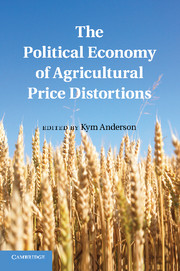Book contents
- Frontmatter
- Contents
- List of Figures
- List of Tables
- Contributors
- Foreword
- Preface
- Abbreviations and Acronyms
- PART ONE Introduction
- PART TWO CONCEPTUAL FRAMEWORKS AND HISTORICAL ORIGINS
- Part Three Political Econometrics: the Past Fifty Years
- NINE Agricultural Price Distortions and Stabilization
- TEN Why Governments Tax or Subsidize Agricultural Trade
- ELEVEN Impacts of Ideology, Inequality, Lobbying, and Public Finance
- TWELVE Agricultural Trade Interventions in Africa
- THIRTEEN Trade Agreements and Trade Barrier Volatility
- FOURTEEN Constitutional Rules and Agricultural Policy Outcomes
- Appendix: Coverage and Distribution of Assistance across Countries and Products, 1955–2007
- Index
- References
THIRTEEN - Trade Agreements and Trade Barrier Volatility
Published online by Cambridge University Press: 05 July 2011
- Frontmatter
- Contents
- List of Figures
- List of Tables
- Contributors
- Foreword
- Preface
- Abbreviations and Acronyms
- PART ONE Introduction
- PART TWO CONCEPTUAL FRAMEWORKS AND HISTORICAL ORIGINS
- Part Three Political Econometrics: the Past Fifty Years
- NINE Agricultural Price Distortions and Stabilization
- TEN Why Governments Tax or Subsidize Agricultural Trade
- ELEVEN Impacts of Ideology, Inequality, Lobbying, and Public Finance
- TWELVE Agricultural Trade Interventions in Africa
- THIRTEEN Trade Agreements and Trade Barrier Volatility
- FOURTEEN Constitutional Rules and Agricultural Policy Outcomes
- Appendix: Coverage and Distribution of Assistance across Countries and Products, 1955–2007
- Index
- References
Summary
The economic analysis of of the politics of Regional Trade Agreements (RTAs) has largely focused so far on how they affect the level of trade distortions. On that count, the verdict is still out: Whereas early political economists held a dim view of their benefits (e.g., Grossman and Helpman 1995 showed that politically feasible RTAs were the most trade-diverting), recent papers (e.g., Ornelas 2005) have taken a more nuanced view, showing that RTAs can release trade-liberalizing forces. However, as noted by Braumoeller (2006), institutional arrangements like RTAs can equally importantly affect the volatility of trade barriers, and that aspect has been largely overlooked (with a few notable exceptions discussed below). We explore empirically here whether RTAs have reduced the volatility of agricultural trade protection rates, using the World Bank's new database on agricultural distortions (Anderson and Valenzuela 2008).
The issue of whether regionalism has dampened the volatility of agricultural trade restrictions is an important one. Volatility in food prices is more likely to trigger riots than volatility in the price of, say, shirts or home appliances. Indeed, Anderson (2009, Ch. 1) shows that border measures have been varied systematically by Asian countries to dampen the volatility of the domestic price of rice, a particularly sensitive commodity in that region. If changes in the level of border measures were used only to insulate domestic markets against terms-of-trade volatility, they could be justified on insurance grounds (Rodrik 1998).
- Type
- Chapter
- Information
- The Political Economy of Agricultural Price Distortions , pp. 332 - 357Publisher: Cambridge University PressPrint publication year: 2010
References
- 3
- Cited by

